A Comparison of Skin Closure Methods in Laparoscopic Surgery
VerifiedAdded on 2023/06/15
|56
|16858
|167
Literature Review
AI Summary
This literature review critically compares skin closure methods—glue, clips, and sutures—following laparoscopic surgery, focusing on safety, efficacy, cosmetic outcomes, patient satisfaction, and healing time. The review analyzes ten Randomized Controlled Trials (RCTs) to determine the optimal method for port site closure. While traditional sutures and clips are deemed safe and effective, they require additional instruments, are time-consuming, and necessitate removal, adding to staff workload and costs. The review advocates for tissue adhesives (glue) as the ideal method due to their simplicity, speed, cost-effectiveness, improved cosmetic results, reduced pain, and bactericidal properties, making them a superior choice for laparoscopic surgery port site closure.
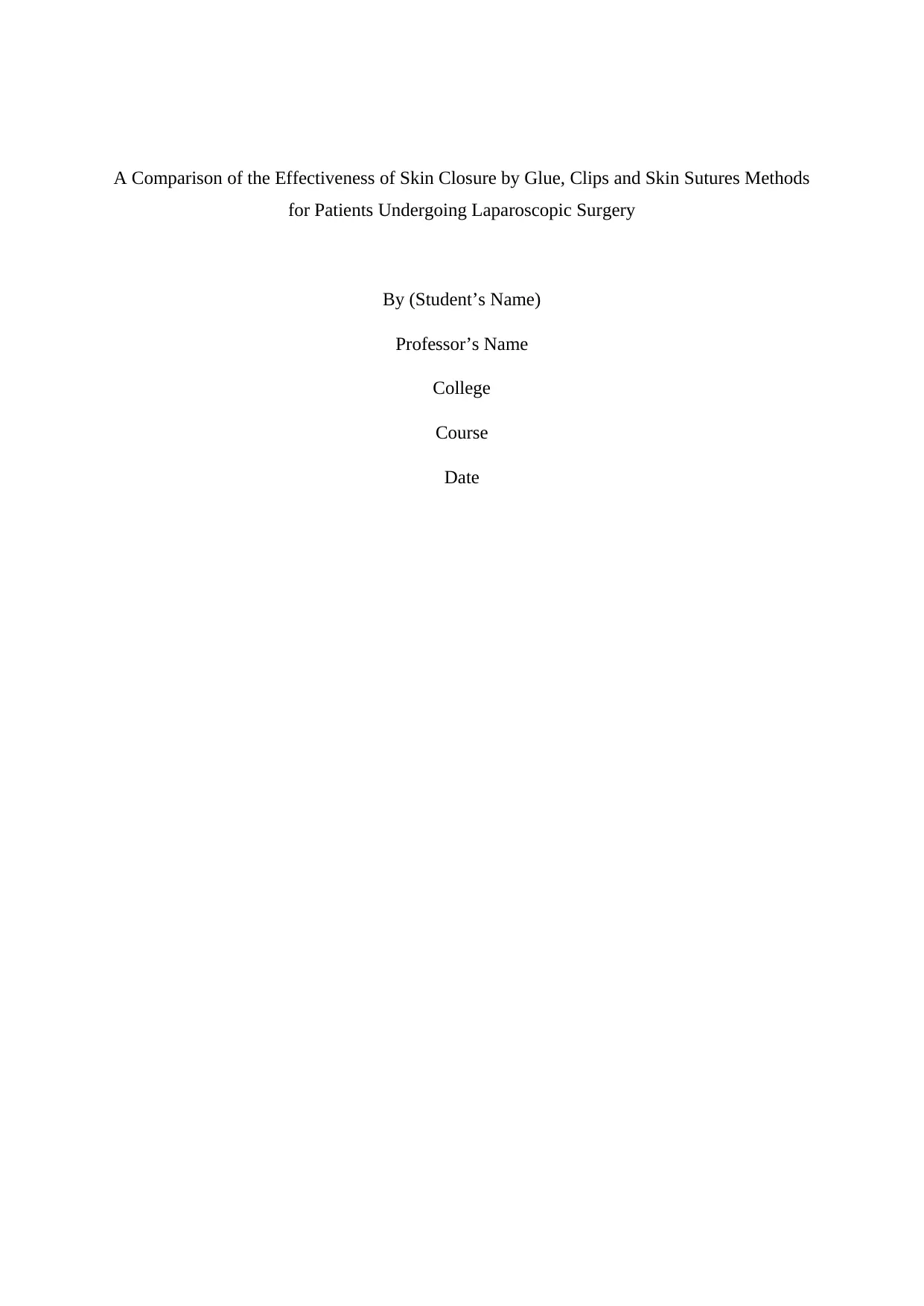
A Comparison of the Effectiveness of Skin Closure by Glue, Clips and Skin Sutures Methods
for Patients Undergoing Laparoscopic Surgery
By (Student’s Name)
Professor’s Name
College
Course
Date
for Patients Undergoing Laparoscopic Surgery
By (Student’s Name)
Professor’s Name
College
Course
Date
Paraphrase This Document
Need a fresh take? Get an instant paraphrase of this document with our AI Paraphraser
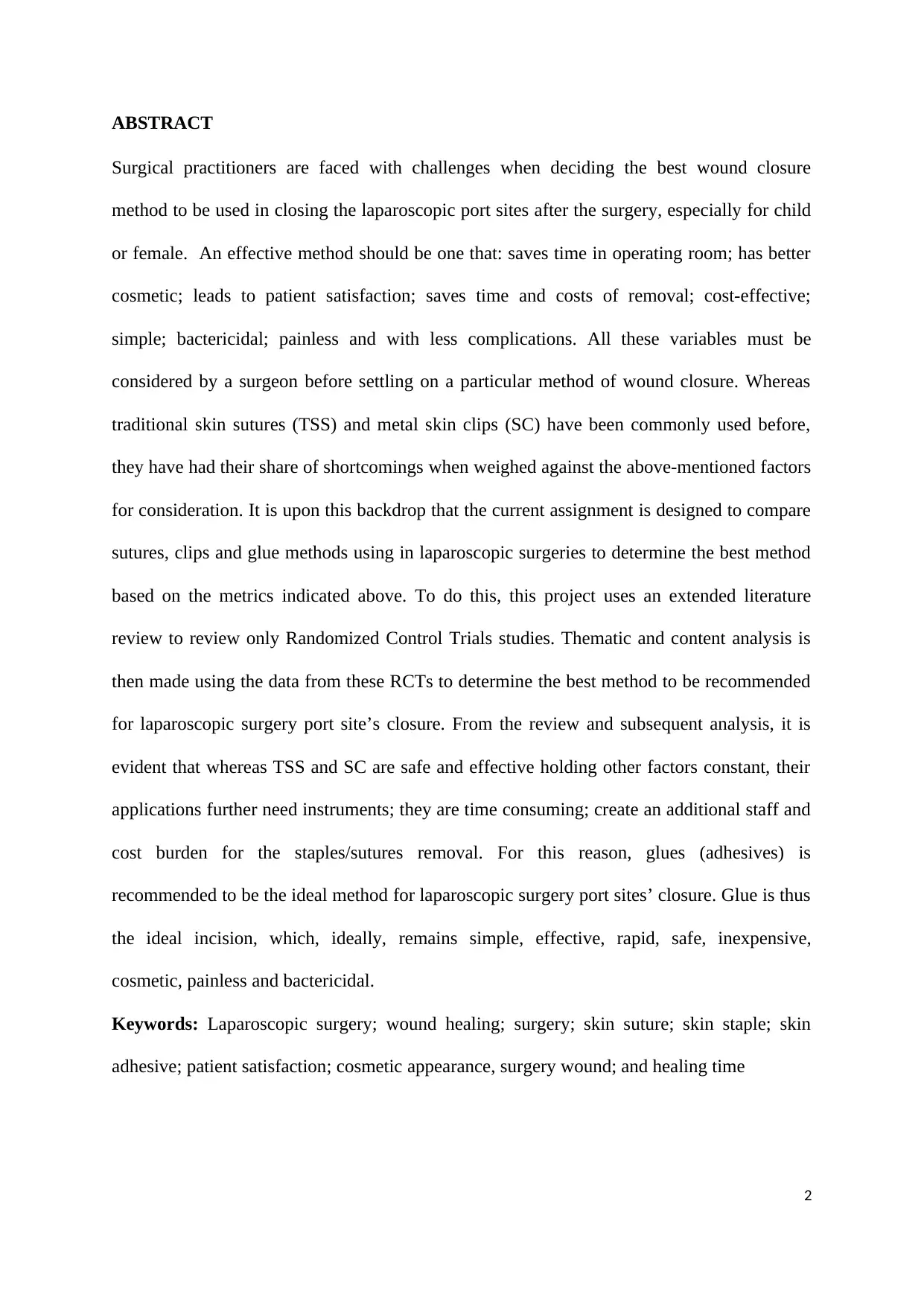
ABSTRACT
Surgical practitioners are faced with challenges when deciding the best wound closure
method to be used in closing the laparoscopic port sites after the surgery, especially for child
or female. An effective method should be one that: saves time in operating room; has better
cosmetic; leads to patient satisfaction; saves time and costs of removal; cost-effective;
simple; bactericidal; painless and with less complications. All these variables must be
considered by a surgeon before settling on a particular method of wound closure. Whereas
traditional skin sutures (TSS) and metal skin clips (SC) have been commonly used before,
they have had their share of shortcomings when weighed against the above-mentioned factors
for consideration. It is upon this backdrop that the current assignment is designed to compare
sutures, clips and glue methods using in laparoscopic surgeries to determine the best method
based on the metrics indicated above. To do this, this project uses an extended literature
review to review only Randomized Control Trials studies. Thematic and content analysis is
then made using the data from these RCTs to determine the best method to be recommended
for laparoscopic surgery port site’s closure. From the review and subsequent analysis, it is
evident that whereas TSS and SC are safe and effective holding other factors constant, their
applications further need instruments; they are time consuming; create an additional staff and
cost burden for the staples/sutures removal. For this reason, glues (adhesives) is
recommended to be the ideal method for laparoscopic surgery port sites’ closure. Glue is thus
the ideal incision, which, ideally, remains simple, effective, rapid, safe, inexpensive,
cosmetic, painless and bactericidal.
Keywords: Laparoscopic surgery; wound healing; surgery; skin suture; skin staple; skin
adhesive; patient satisfaction; cosmetic appearance, surgery wound; and healing time
2
Surgical practitioners are faced with challenges when deciding the best wound closure
method to be used in closing the laparoscopic port sites after the surgery, especially for child
or female. An effective method should be one that: saves time in operating room; has better
cosmetic; leads to patient satisfaction; saves time and costs of removal; cost-effective;
simple; bactericidal; painless and with less complications. All these variables must be
considered by a surgeon before settling on a particular method of wound closure. Whereas
traditional skin sutures (TSS) and metal skin clips (SC) have been commonly used before,
they have had their share of shortcomings when weighed against the above-mentioned factors
for consideration. It is upon this backdrop that the current assignment is designed to compare
sutures, clips and glue methods using in laparoscopic surgeries to determine the best method
based on the metrics indicated above. To do this, this project uses an extended literature
review to review only Randomized Control Trials studies. Thematic and content analysis is
then made using the data from these RCTs to determine the best method to be recommended
for laparoscopic surgery port site’s closure. From the review and subsequent analysis, it is
evident that whereas TSS and SC are safe and effective holding other factors constant, their
applications further need instruments; they are time consuming; create an additional staff and
cost burden for the staples/sutures removal. For this reason, glues (adhesives) is
recommended to be the ideal method for laparoscopic surgery port sites’ closure. Glue is thus
the ideal incision, which, ideally, remains simple, effective, rapid, safe, inexpensive,
cosmetic, painless and bactericidal.
Keywords: Laparoscopic surgery; wound healing; surgery; skin suture; skin staple; skin
adhesive; patient satisfaction; cosmetic appearance, surgery wound; and healing time
2
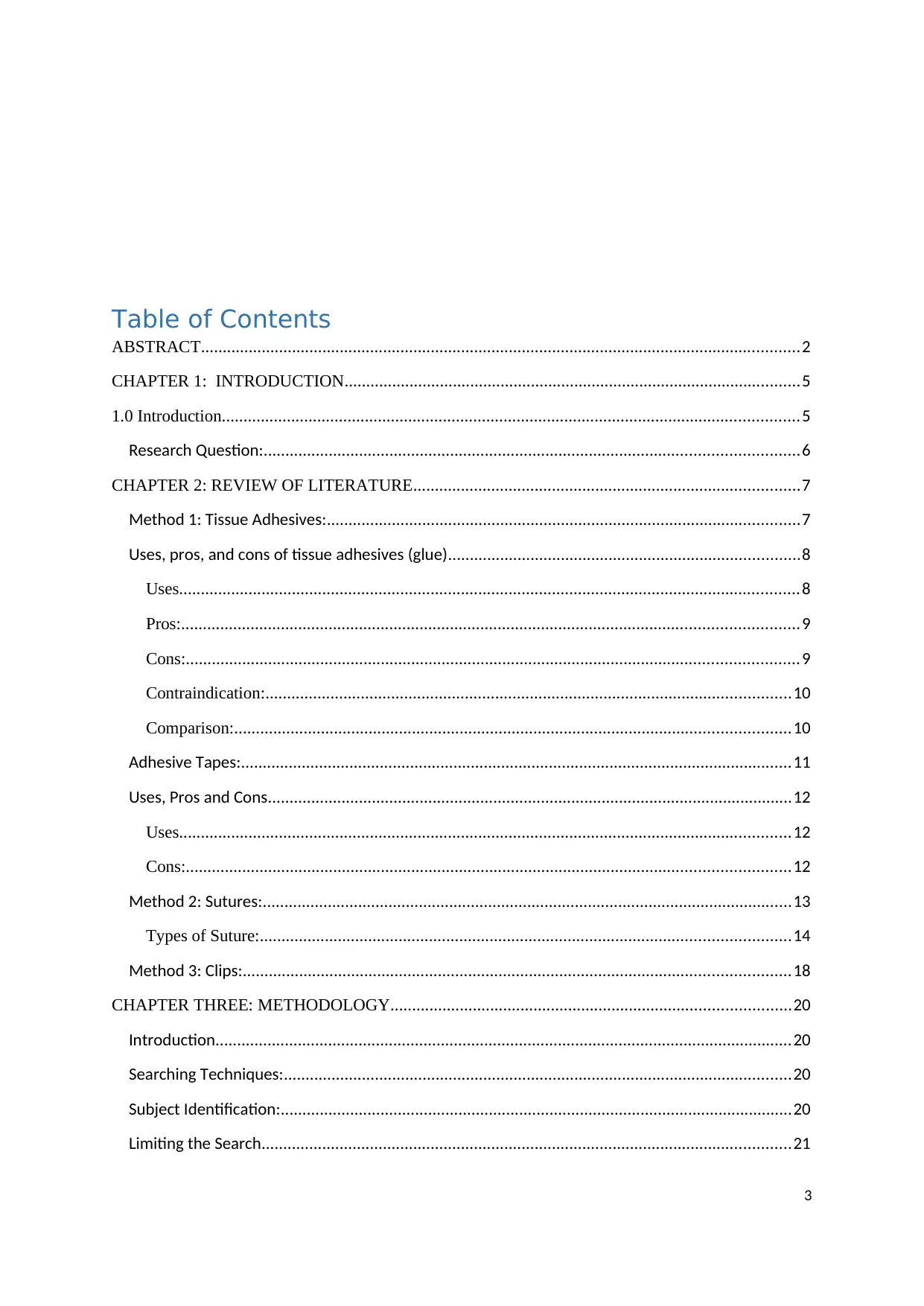
Table of Contents
ABSTRACT..........................................................................................................................................2
CHAPTER 1: INTRODUCTION.........................................................................................................5
1.0 Introduction.....................................................................................................................................5
Research Question:...........................................................................................................................6
CHAPTER 2: REVIEW OF LITERATURE.........................................................................................7
Method 1: Tissue Adhesives:.............................................................................................................7
Uses, pros, and cons of tissue adhesives (glue).................................................................................8
Uses...............................................................................................................................................8
Pros:..............................................................................................................................................9
Cons:.............................................................................................................................................9
Contraindication:.........................................................................................................................10
Comparison:................................................................................................................................10
Adhesive Tapes:...............................................................................................................................11
Uses, Pros and Cons.........................................................................................................................12
Uses.............................................................................................................................................12
Cons:...........................................................................................................................................12
Method 2: Sutures:..........................................................................................................................13
Types of Suture:..........................................................................................................................14
Method 3: Clips:..............................................................................................................................18
CHAPTER THREE: METHODOLOGY............................................................................................20
Introduction.....................................................................................................................................20
Searching Techniques:.....................................................................................................................20
Subject Identification:......................................................................................................................20
Limiting the Search..........................................................................................................................21
3
ABSTRACT..........................................................................................................................................2
CHAPTER 1: INTRODUCTION.........................................................................................................5
1.0 Introduction.....................................................................................................................................5
Research Question:...........................................................................................................................6
CHAPTER 2: REVIEW OF LITERATURE.........................................................................................7
Method 1: Tissue Adhesives:.............................................................................................................7
Uses, pros, and cons of tissue adhesives (glue).................................................................................8
Uses...............................................................................................................................................8
Pros:..............................................................................................................................................9
Cons:.............................................................................................................................................9
Contraindication:.........................................................................................................................10
Comparison:................................................................................................................................10
Adhesive Tapes:...............................................................................................................................11
Uses, Pros and Cons.........................................................................................................................12
Uses.............................................................................................................................................12
Cons:...........................................................................................................................................12
Method 2: Sutures:..........................................................................................................................13
Types of Suture:..........................................................................................................................14
Method 3: Clips:..............................................................................................................................18
CHAPTER THREE: METHODOLOGY............................................................................................20
Introduction.....................................................................................................................................20
Searching Techniques:.....................................................................................................................20
Subject Identification:......................................................................................................................20
Limiting the Search..........................................................................................................................21
3
⊘ This is a preview!⊘
Do you want full access?
Subscribe today to unlock all pages.

Trusted by 1+ million students worldwide
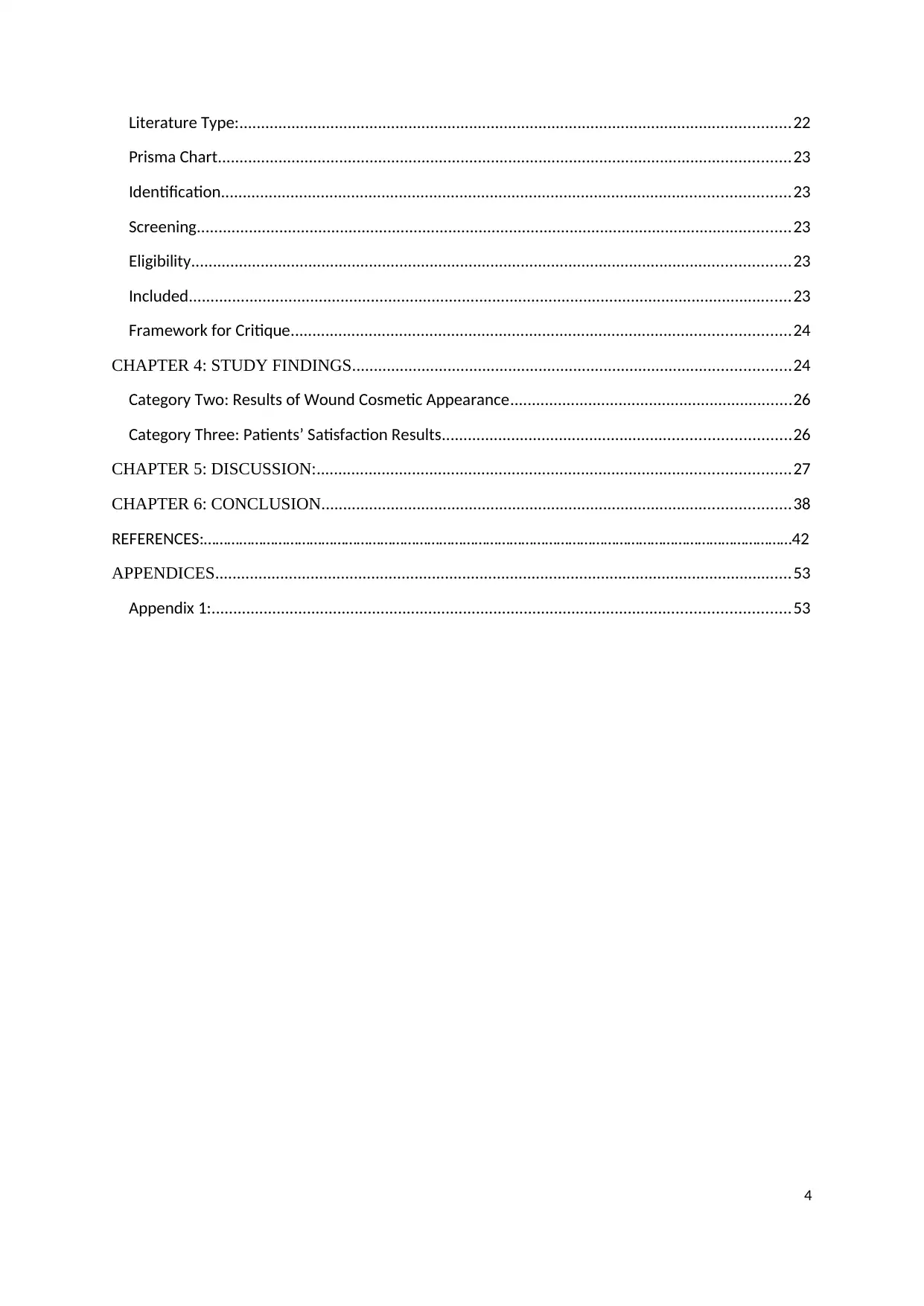
Literature Type:...............................................................................................................................22
Prisma Chart....................................................................................................................................23
Identification...................................................................................................................................23
Screening.........................................................................................................................................23
Eligibility..........................................................................................................................................23
Included...........................................................................................................................................23
Framework for Critique...................................................................................................................24
CHAPTER 4: STUDY FINDINGS.....................................................................................................24
Category Two: Results of Wound Cosmetic Appearance.................................................................26
Category Three: Patients’ Satisfaction Results................................................................................26
CHAPTER 5: DISCUSSION:.............................................................................................................27
CHAPTER 6: CONCLUSION............................................................................................................38
REFERENCES:……………………………………………………………………………………………………………………………………42
APPENDICES.....................................................................................................................................53
Appendix 1:.....................................................................................................................................53
4
Prisma Chart....................................................................................................................................23
Identification...................................................................................................................................23
Screening.........................................................................................................................................23
Eligibility..........................................................................................................................................23
Included...........................................................................................................................................23
Framework for Critique...................................................................................................................24
CHAPTER 4: STUDY FINDINGS.....................................................................................................24
Category Two: Results of Wound Cosmetic Appearance.................................................................26
Category Three: Patients’ Satisfaction Results................................................................................26
CHAPTER 5: DISCUSSION:.............................................................................................................27
CHAPTER 6: CONCLUSION............................................................................................................38
REFERENCES:……………………………………………………………………………………………………………………………………42
APPENDICES.....................................................................................................................................53
Appendix 1:.....................................................................................................................................53
4
Paraphrase This Document
Need a fresh take? Get an instant paraphrase of this document with our AI Paraphraser
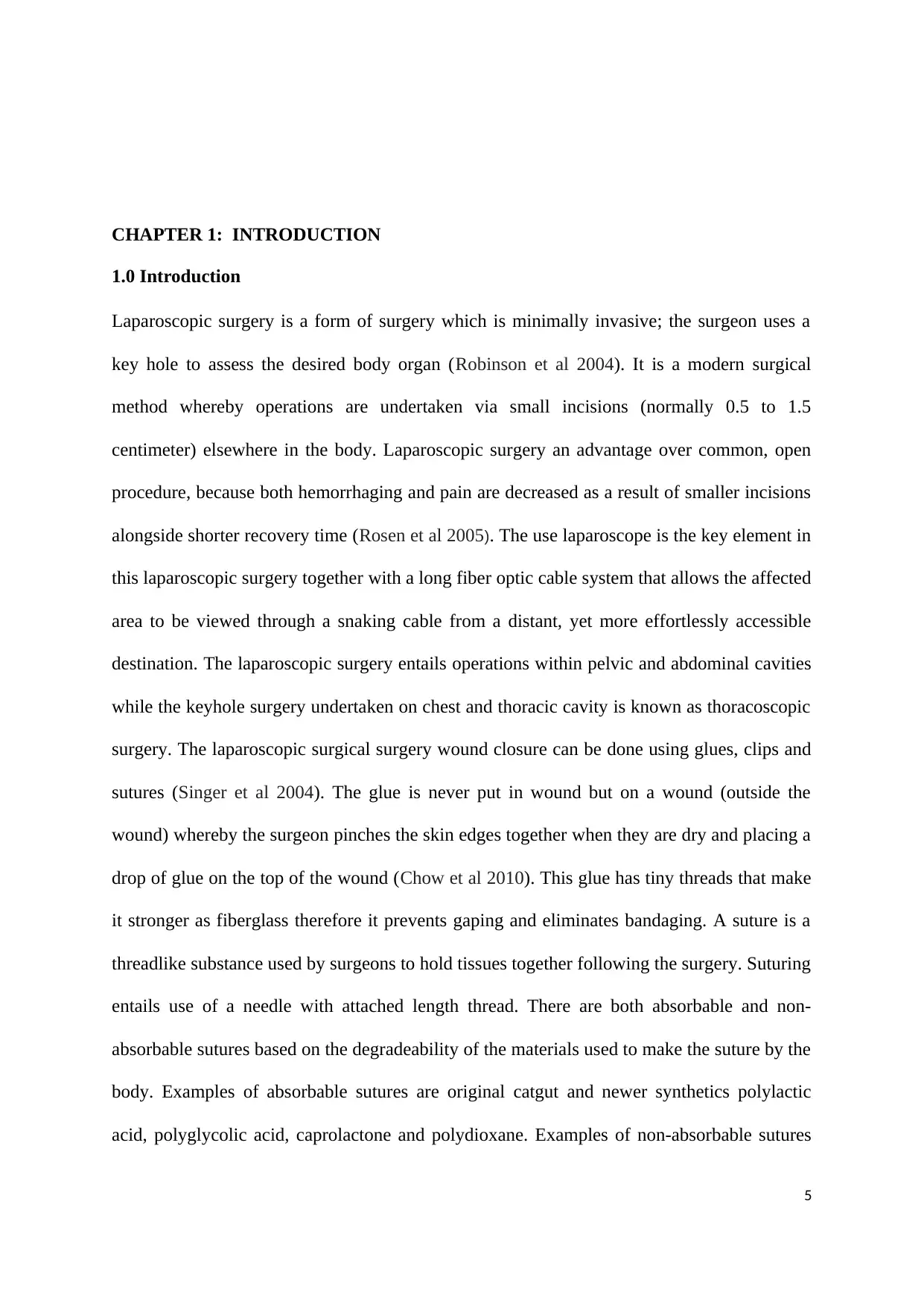
CHAPTER 1: INTRODUCTION
1.0 Introduction
Laparoscopic surgery is a form of surgery which is minimally invasive; the surgeon uses a
key hole to assess the desired body organ (Robinson et al 2004). It is a modern surgical
method whereby operations are undertaken via small incisions (normally 0.5 to 1.5
centimeter) elsewhere in the body. Laparoscopic surgery an advantage over common, open
procedure, because both hemorrhaging and pain are decreased as a result of smaller incisions
alongside shorter recovery time (Rosen et al 2005). The use laparoscope is the key element in
this laparoscopic surgery together with a long fiber optic cable system that allows the affected
area to be viewed through a snaking cable from a distant, yet more effortlessly accessible
destination. The laparoscopic surgery entails operations within pelvic and abdominal cavities
while the keyhole surgery undertaken on chest and thoracic cavity is known as thoracoscopic
surgery. The laparoscopic surgical surgery wound closure can be done using glues, clips and
sutures (Singer et al 2004). The glue is never put in wound but on a wound (outside the
wound) whereby the surgeon pinches the skin edges together when they are dry and placing a
drop of glue on the top of the wound (Chow et al 2010). This glue has tiny threads that make
it stronger as fiberglass therefore it prevents gaping and eliminates bandaging. A suture is a
threadlike substance used by surgeons to hold tissues together following the surgery. Suturing
entails use of a needle with attached length thread. There are both absorbable and non-
absorbable sutures based on the degradeability of the materials used to make the suture by the
body. Examples of absorbable sutures are original catgut and newer synthetics polylactic
acid, polyglycolic acid, caprolactone and polydioxane. Examples of non-absorbable sutures
5
1.0 Introduction
Laparoscopic surgery is a form of surgery which is minimally invasive; the surgeon uses a
key hole to assess the desired body organ (Robinson et al 2004). It is a modern surgical
method whereby operations are undertaken via small incisions (normally 0.5 to 1.5
centimeter) elsewhere in the body. Laparoscopic surgery an advantage over common, open
procedure, because both hemorrhaging and pain are decreased as a result of smaller incisions
alongside shorter recovery time (Rosen et al 2005). The use laparoscope is the key element in
this laparoscopic surgery together with a long fiber optic cable system that allows the affected
area to be viewed through a snaking cable from a distant, yet more effortlessly accessible
destination. The laparoscopic surgery entails operations within pelvic and abdominal cavities
while the keyhole surgery undertaken on chest and thoracic cavity is known as thoracoscopic
surgery. The laparoscopic surgical surgery wound closure can be done using glues, clips and
sutures (Singer et al 2004). The glue is never put in wound but on a wound (outside the
wound) whereby the surgeon pinches the skin edges together when they are dry and placing a
drop of glue on the top of the wound (Chow et al 2010). This glue has tiny threads that make
it stronger as fiberglass therefore it prevents gaping and eliminates bandaging. A suture is a
threadlike substance used by surgeons to hold tissues together following the surgery. Suturing
entails use of a needle with attached length thread. There are both absorbable and non-
absorbable sutures based on the degradeability of the materials used to make the suture by the
body. Examples of absorbable sutures are original catgut and newer synthetics polylactic
acid, polyglycolic acid, caprolactone and polydioxane. Examples of non-absorbable sutures
5

are made of silk or synthetic polyester, nylon or polypropylene. Clips have “teeth’ that offer
better clamping and wound closure of skin. The clips are also easy to remove following
recovery and have less trauma and usable with existing 9mm removers and applies. They are
perfect for swiftly closing wounds as they provide maximum holding force with fewer
traumas, and remain much easier and swifter to use as opposed to traditional sutures.
This extended literature review is designed to critically review the existing literature and
compare the use of skin closure by glue, clip, and suture in laparoscopic surgery to determine
the safety as well as the efficacy of the three materials. A review of ten RCT studies is done
to compare all these wound closure substances.
In essence, a surgical incision closure method has to be economical, time saving, simple to
perform, as well as provide an optimal cosmetic outcome. Albeit sutures are frequently used
in surgery, unlimited number of reviews are available in the field which compares or even
assessment the qualities and attributes of the sutures. Over the decades, the study on critical
wound healing has culminated in the technological advamncement of staples and tissues
adhesive methods. Scientist and medical researchers have conducted studies to analyze the
different types materials used for wound closure including laser assisted tissue bonding
(Simohon, Gabay and Shpolyansky et al,,, 2015).
Research Question:
Which are the most effective wound closure methods (glue, clip, or sutures) in laparoscopic
surgery?
Aim and objectives of the study:
This study is aimed at investigating which wound closure technique is most effective during
laparoscopic surgery
Specific objectives:
6
better clamping and wound closure of skin. The clips are also easy to remove following
recovery and have less trauma and usable with existing 9mm removers and applies. They are
perfect for swiftly closing wounds as they provide maximum holding force with fewer
traumas, and remain much easier and swifter to use as opposed to traditional sutures.
This extended literature review is designed to critically review the existing literature and
compare the use of skin closure by glue, clip, and suture in laparoscopic surgery to determine
the safety as well as the efficacy of the three materials. A review of ten RCT studies is done
to compare all these wound closure substances.
In essence, a surgical incision closure method has to be economical, time saving, simple to
perform, as well as provide an optimal cosmetic outcome. Albeit sutures are frequently used
in surgery, unlimited number of reviews are available in the field which compares or even
assessment the qualities and attributes of the sutures. Over the decades, the study on critical
wound healing has culminated in the technological advamncement of staples and tissues
adhesive methods. Scientist and medical researchers have conducted studies to analyze the
different types materials used for wound closure including laser assisted tissue bonding
(Simohon, Gabay and Shpolyansky et al,,, 2015).
Research Question:
Which are the most effective wound closure methods (glue, clip, or sutures) in laparoscopic
surgery?
Aim and objectives of the study:
This study is aimed at investigating which wound closure technique is most effective during
laparoscopic surgery
Specific objectives:
6
⊘ This is a preview!⊘
Do you want full access?
Subscribe today to unlock all pages.

Trusted by 1+ million students worldwide
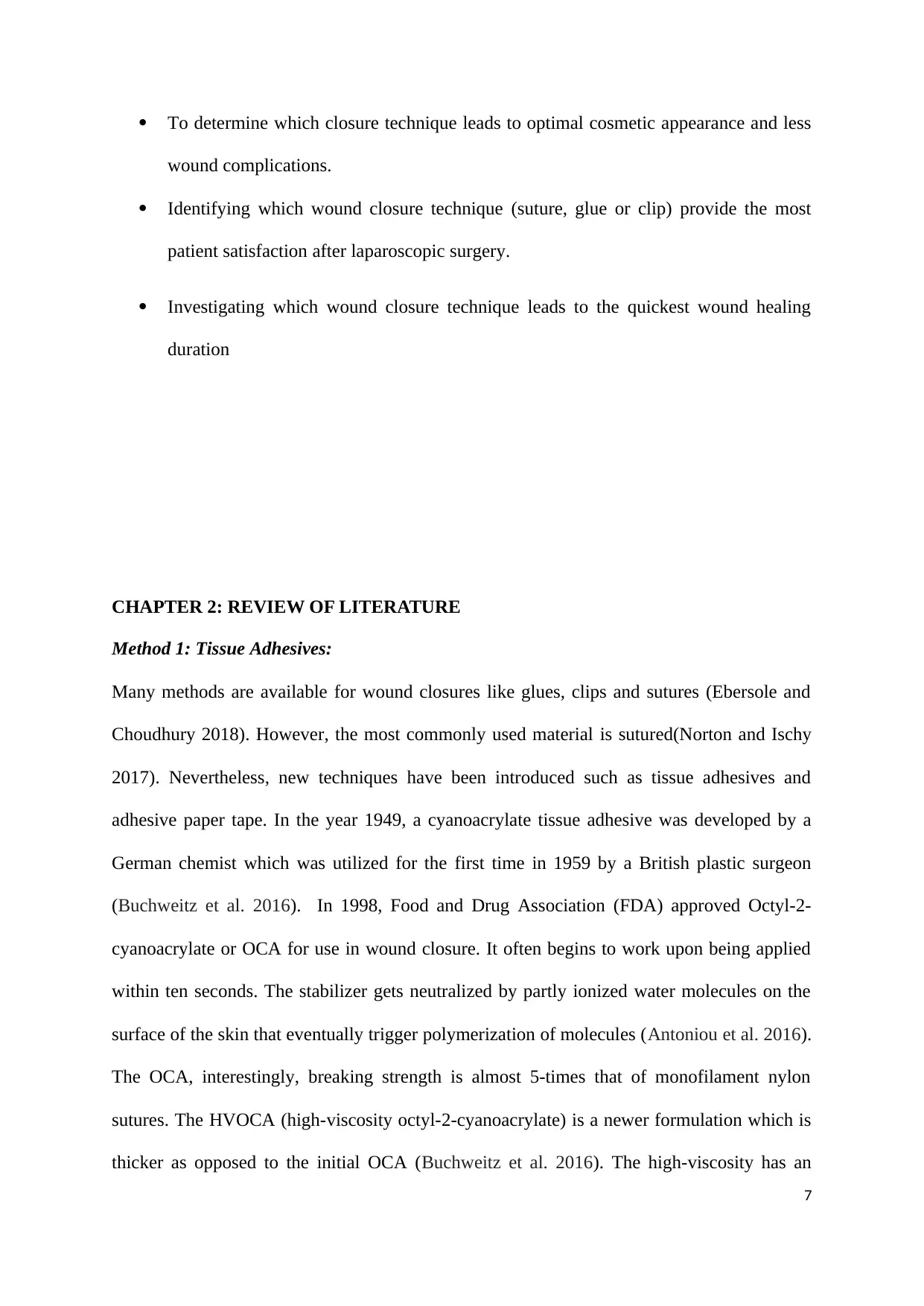
To determine which closure technique leads to optimal cosmetic appearance and less
wound complications.
Identifying which wound closure technique (suture, glue or clip) provide the most
patient satisfaction after laparoscopic surgery.
Investigating which wound closure technique leads to the quickest wound healing
duration
CHAPTER 2: REVIEW OF LITERATURE
Method 1: Tissue Adhesives:
Many methods are available for wound closures like glues, clips and sutures (Ebersole and
Choudhury 2018). However, the most commonly used material is sutured(Norton and Ischy
2017). Nevertheless, new techniques have been introduced such as tissue adhesives and
adhesive paper tape. In the year 1949, a cyanoacrylate tissue adhesive was developed by a
German chemist which was utilized for the first time in 1959 by a British plastic surgeon
(Buchweitz et al. 2016). In 1998, Food and Drug Association (FDA) approved Octyl-2-
cyanoacrylate or OCA for use in wound closure. It often begins to work upon being applied
within ten seconds. The stabilizer gets neutralized by partly ionized water molecules on the
surface of the skin that eventually trigger polymerization of molecules (Antoniou et al. 2016).
The OCA, interestingly, breaking strength is almost 5-times that of monofilament nylon
sutures. The HVOCA (high-viscosity octyl-2-cyanoacrylate) is a newer formulation which is
thicker as opposed to the initial OCA (Buchweitz et al. 2016). The high-viscosity has an
7
wound complications.
Identifying which wound closure technique (suture, glue or clip) provide the most
patient satisfaction after laparoscopic surgery.
Investigating which wound closure technique leads to the quickest wound healing
duration
CHAPTER 2: REVIEW OF LITERATURE
Method 1: Tissue Adhesives:
Many methods are available for wound closures like glues, clips and sutures (Ebersole and
Choudhury 2018). However, the most commonly used material is sutured(Norton and Ischy
2017). Nevertheless, new techniques have been introduced such as tissue adhesives and
adhesive paper tape. In the year 1949, a cyanoacrylate tissue adhesive was developed by a
German chemist which was utilized for the first time in 1959 by a British plastic surgeon
(Buchweitz et al. 2016). In 1998, Food and Drug Association (FDA) approved Octyl-2-
cyanoacrylate or OCA for use in wound closure. It often begins to work upon being applied
within ten seconds. The stabilizer gets neutralized by partly ionized water molecules on the
surface of the skin that eventually trigger polymerization of molecules (Antoniou et al. 2016).
The OCA, interestingly, breaking strength is almost 5-times that of monofilament nylon
sutures. The HVOCA (high-viscosity octyl-2-cyanoacrylate) is a newer formulation which is
thicker as opposed to the initial OCA (Buchweitz et al. 2016). The high-viscosity has an
7
Paraphrase This Document
Need a fresh take? Get an instant paraphrase of this document with our AI Paraphraser

advantage of risk reduction; the adhesive is applied away from the wound, there-by
enhancing the cosmetics of the skin. Under five-ten days, the adhesive sloughs of generally as
the wound re-epithelialize (Chen et al. 2010). Premature sloughing of the adhesive could
arise from topical ointment alongside frequent wound cleansing when it is treated with OCA.
Many new reports have illustrated the OCA effectiveness of skin closure in a broad range of
clinical context as well as surgical subspecialists (Park et al. 2015). The wound has to be
evaluated before the application of the adhesive for the subcutaneous sutures placement to
reduce the tension of the wound, elimination of subcutaneous dead space as well as
maximization of skin edge eversion (Buchweitz et al. 2016).
Uses, pros, and cons of tissue adhesives (glue)
( Al-mubarak and Al-Haddab 2013)
Uses
Tissues adhesives have already been utilized for decades in both major and minor skin
closure procedures. These materials have widespread applications and indications and have
been utilized for tissue adhesion, implants fixation, cerebrospinal fluid leaks closure as well
as blood vessels’ embolization (Buchweitz et al. 2016). Besides, these materials are currently
being utilized for groin wounds, facial wounds, laparoscopic surgical wounds,
blepharoplasty, hand surgery, and lacrimal punctum closure as well as hair transplantation.
8
enhancing the cosmetics of the skin. Under five-ten days, the adhesive sloughs of generally as
the wound re-epithelialize (Chen et al. 2010). Premature sloughing of the adhesive could
arise from topical ointment alongside frequent wound cleansing when it is treated with OCA.
Many new reports have illustrated the OCA effectiveness of skin closure in a broad range of
clinical context as well as surgical subspecialists (Park et al. 2015). The wound has to be
evaluated before the application of the adhesive for the subcutaneous sutures placement to
reduce the tension of the wound, elimination of subcutaneous dead space as well as
maximization of skin edge eversion (Buchweitz et al. 2016).
Uses, pros, and cons of tissue adhesives (glue)
( Al-mubarak and Al-Haddab 2013)
Uses
Tissues adhesives have already been utilized for decades in both major and minor skin
closure procedures. These materials have widespread applications and indications and have
been utilized for tissue adhesion, implants fixation, cerebrospinal fluid leaks closure as well
as blood vessels’ embolization (Buchweitz et al. 2016). Besides, these materials are currently
being utilized for groin wounds, facial wounds, laparoscopic surgical wounds,
blepharoplasty, hand surgery, and lacrimal punctum closure as well as hair transplantation.
8
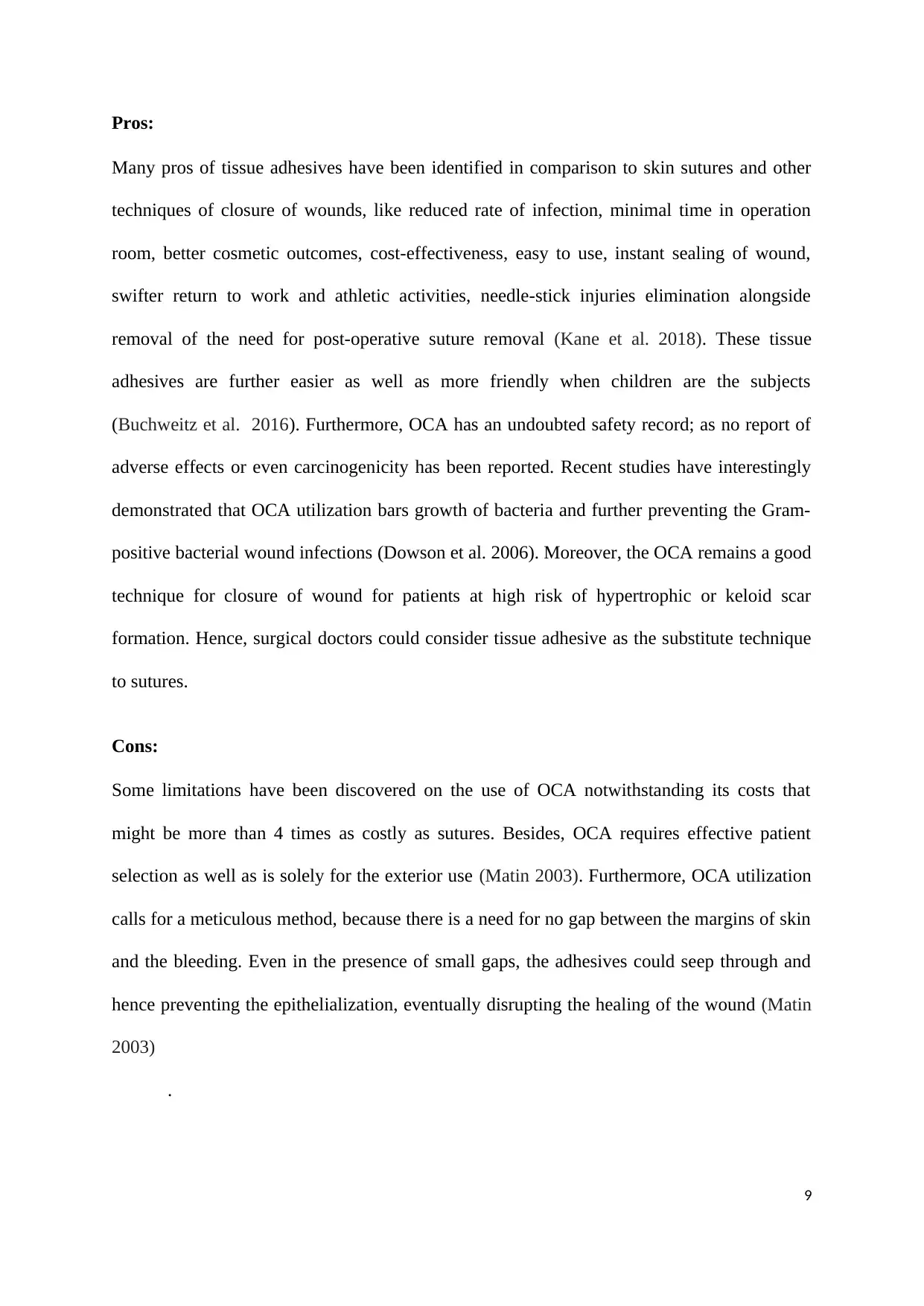
Pros:
Many pros of tissue adhesives have been identified in comparison to skin sutures and other
techniques of closure of wounds, like reduced rate of infection, minimal time in operation
room, better cosmetic outcomes, cost-effectiveness, easy to use, instant sealing of wound,
swifter return to work and athletic activities, needle-stick injuries elimination alongside
removal of the need for post-operative suture removal (Kane et al. 2018). These tissue
adhesives are further easier as well as more friendly when children are the subjects
(Buchweitz et al. 2016). Furthermore, OCA has an undoubted safety record; as no report of
adverse effects or even carcinogenicity has been reported. Recent studies have interestingly
demonstrated that OCA utilization bars growth of bacteria and further preventing the Gram-
positive bacterial wound infections (Dowson et al. 2006). Moreover, the OCA remains a good
technique for closure of wound for patients at high risk of hypertrophic or keloid scar
formation. Hence, surgical doctors could consider tissue adhesive as the substitute technique
to sutures.
Cons:
Some limitations have been discovered on the use of OCA notwithstanding its costs that
might be more than 4 times as costly as sutures. Besides, OCA requires effective patient
selection as well as is solely for the exterior use (Matin 2003). Furthermore, OCA utilization
calls for a meticulous method, because there is a need for no gap between the margins of skin
and the bleeding. Even in the presence of small gaps, the adhesives could seep through and
hence preventing the epithelialization, eventually disrupting the healing of the wound (Matin
2003)
.
9
Many pros of tissue adhesives have been identified in comparison to skin sutures and other
techniques of closure of wounds, like reduced rate of infection, minimal time in operation
room, better cosmetic outcomes, cost-effectiveness, easy to use, instant sealing of wound,
swifter return to work and athletic activities, needle-stick injuries elimination alongside
removal of the need for post-operative suture removal (Kane et al. 2018). These tissue
adhesives are further easier as well as more friendly when children are the subjects
(Buchweitz et al. 2016). Furthermore, OCA has an undoubted safety record; as no report of
adverse effects or even carcinogenicity has been reported. Recent studies have interestingly
demonstrated that OCA utilization bars growth of bacteria and further preventing the Gram-
positive bacterial wound infections (Dowson et al. 2006). Moreover, the OCA remains a good
technique for closure of wound for patients at high risk of hypertrophic or keloid scar
formation. Hence, surgical doctors could consider tissue adhesive as the substitute technique
to sutures.
Cons:
Some limitations have been discovered on the use of OCA notwithstanding its costs that
might be more than 4 times as costly as sutures. Besides, OCA requires effective patient
selection as well as is solely for the exterior use (Matin 2003). Furthermore, OCA utilization
calls for a meticulous method, because there is a need for no gap between the margins of skin
and the bleeding. Even in the presence of small gaps, the adhesives could seep through and
hence preventing the epithelialization, eventually disrupting the healing of the wound (Matin
2003)
.
9
⊘ This is a preview!⊘
Do you want full access?
Subscribe today to unlock all pages.

Trusted by 1+ million students worldwide
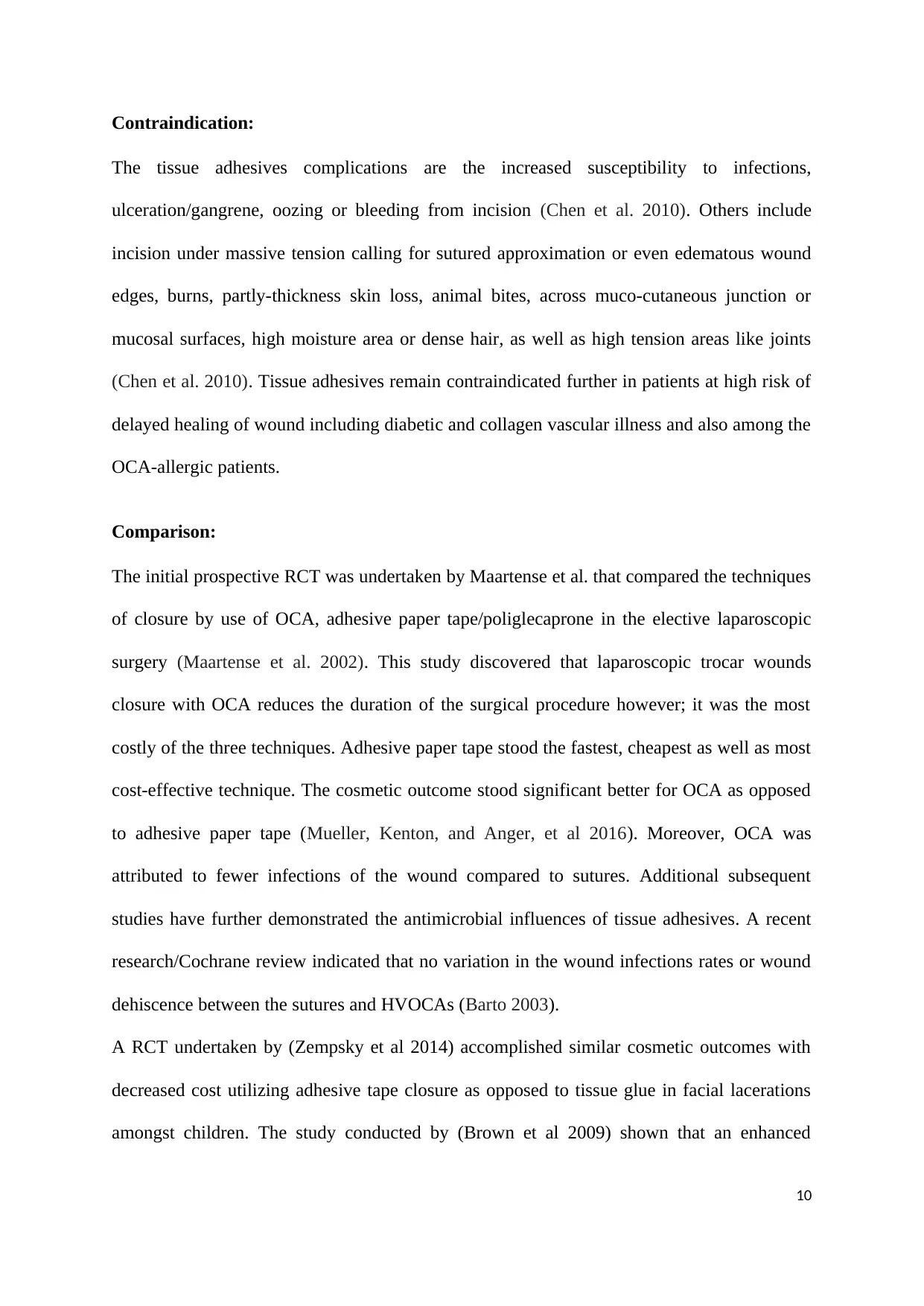
Contraindication:
The tissue adhesives complications are the increased susceptibility to infections,
ulceration/gangrene, oozing or bleeding from incision (Chen et al. 2010). Others include
incision under massive tension calling for sutured approximation or even edematous wound
edges, burns, partly-thickness skin loss, animal bites, across muco-cutaneous junction or
mucosal surfaces, high moisture area or dense hair, as well as high tension areas like joints
(Chen et al. 2010). Tissue adhesives remain contraindicated further in patients at high risk of
delayed healing of wound including diabetic and collagen vascular illness and also among the
OCA-allergic patients.
Comparison:
The initial prospective RCT was undertaken by Maartense et al. that compared the techniques
of closure by use of OCA, adhesive paper tape/poliglecaprone in the elective laparoscopic
surgery (Maartense et al. 2002). This study discovered that laparoscopic trocar wounds
closure with OCA reduces the duration of the surgical procedure however; it was the most
costly of the three techniques. Adhesive paper tape stood the fastest, cheapest as well as most
cost-effective technique. The cosmetic outcome stood significant better for OCA as opposed
to adhesive paper tape (Mueller, Kenton, and Anger, et al 2016). Moreover, OCA was
attributed to fewer infections of the wound compared to sutures. Additional subsequent
studies have further demonstrated the antimicrobial influences of tissue adhesives. A recent
research/Cochrane review indicated that no variation in the wound infections rates or wound
dehiscence between the sutures and HVOCAs (Barto 2003).
A RCT undertaken by (Zempsky et al 2014) accomplished similar cosmetic outcomes with
decreased cost utilizing adhesive tape closure as opposed to tissue glue in facial lacerations
amongst children. The study conducted by (Brown et al 2009) shown that an enhanced
10
The tissue adhesives complications are the increased susceptibility to infections,
ulceration/gangrene, oozing or bleeding from incision (Chen et al. 2010). Others include
incision under massive tension calling for sutured approximation or even edematous wound
edges, burns, partly-thickness skin loss, animal bites, across muco-cutaneous junction or
mucosal surfaces, high moisture area or dense hair, as well as high tension areas like joints
(Chen et al. 2010). Tissue adhesives remain contraindicated further in patients at high risk of
delayed healing of wound including diabetic and collagen vascular illness and also among the
OCA-allergic patients.
Comparison:
The initial prospective RCT was undertaken by Maartense et al. that compared the techniques
of closure by use of OCA, adhesive paper tape/poliglecaprone in the elective laparoscopic
surgery (Maartense et al. 2002). This study discovered that laparoscopic trocar wounds
closure with OCA reduces the duration of the surgical procedure however; it was the most
costly of the three techniques. Adhesive paper tape stood the fastest, cheapest as well as most
cost-effective technique. The cosmetic outcome stood significant better for OCA as opposed
to adhesive paper tape (Mueller, Kenton, and Anger, et al 2016). Moreover, OCA was
attributed to fewer infections of the wound compared to sutures. Additional subsequent
studies have further demonstrated the antimicrobial influences of tissue adhesives. A recent
research/Cochrane review indicated that no variation in the wound infections rates or wound
dehiscence between the sutures and HVOCAs (Barto 2003).
A RCT undertaken by (Zempsky et al 2014) accomplished similar cosmetic outcomes with
decreased cost utilizing adhesive tape closure as opposed to tissue glue in facial lacerations
amongst children. The study conducted by (Brown et al 2009) shown that an enhanced
10
Paraphrase This Document
Need a fresh take? Get an instant paraphrase of this document with our AI Paraphraser

cosmetic result when suturing was utilized to close wounds engaging tissue excision, leading
to higher tension of wound. The corresponding cosmetic outcome with OCA alongside
sutured closure utilization was satisfactory. A prospective RCT indicated that skin closure in
the traumatic wounds utilizing 2-OCA produced outcomes that were comparable to those of
the standard sutured closure in respect of rates of infection, long-term cosmetic outcome and
dehiscence (Maartense et al. 2002).
Adhesive Tapes:
The surgical adhesive tapes often entail an adhesive backing entailing iso-octo-acrylate
together with n-vinyl-pryolidone. The ideal surgical adhesive tape needs to be non-allergic,
water-resistant, non-irritating, vapor permeable as well as have to be strictly adhered to skin
(Buchweitz et al. 2016). Adhesive tapes are utilized most often as adjunctive wound
assistance/support following staples or even sutures removal, together with buried dermal
sutures, or even with absorbable running subcuticular sutures in the less-tension wounds
(Buchweitz et al. 2016). The application of surgical adhesive tapes in the parallel, non-
overlapping fashion following coating the whole area of application with the adjuvant
adhesive remains the optimal application method which showed the best adherence over a
period of time, as well as several significant variables in tape application have been noted
encompassing dry skin acute edges’ apposition, strict homeostasis as well as utilization of an
adhesive adjunct; besides, tension has to be disseminated along the whole tape to bar blisters
(Maartense et al. 2002).
11
to higher tension of wound. The corresponding cosmetic outcome with OCA alongside
sutured closure utilization was satisfactory. A prospective RCT indicated that skin closure in
the traumatic wounds utilizing 2-OCA produced outcomes that were comparable to those of
the standard sutured closure in respect of rates of infection, long-term cosmetic outcome and
dehiscence (Maartense et al. 2002).
Adhesive Tapes:
The surgical adhesive tapes often entail an adhesive backing entailing iso-octo-acrylate
together with n-vinyl-pryolidone. The ideal surgical adhesive tape needs to be non-allergic,
water-resistant, non-irritating, vapor permeable as well as have to be strictly adhered to skin
(Buchweitz et al. 2016). Adhesive tapes are utilized most often as adjunctive wound
assistance/support following staples or even sutures removal, together with buried dermal
sutures, or even with absorbable running subcuticular sutures in the less-tension wounds
(Buchweitz et al. 2016). The application of surgical adhesive tapes in the parallel, non-
overlapping fashion following coating the whole area of application with the adjuvant
adhesive remains the optimal application method which showed the best adherence over a
period of time, as well as several significant variables in tape application have been noted
encompassing dry skin acute edges’ apposition, strict homeostasis as well as utilization of an
adhesive adjunct; besides, tension has to be disseminated along the whole tape to bar blisters
(Maartense et al. 2002).
11
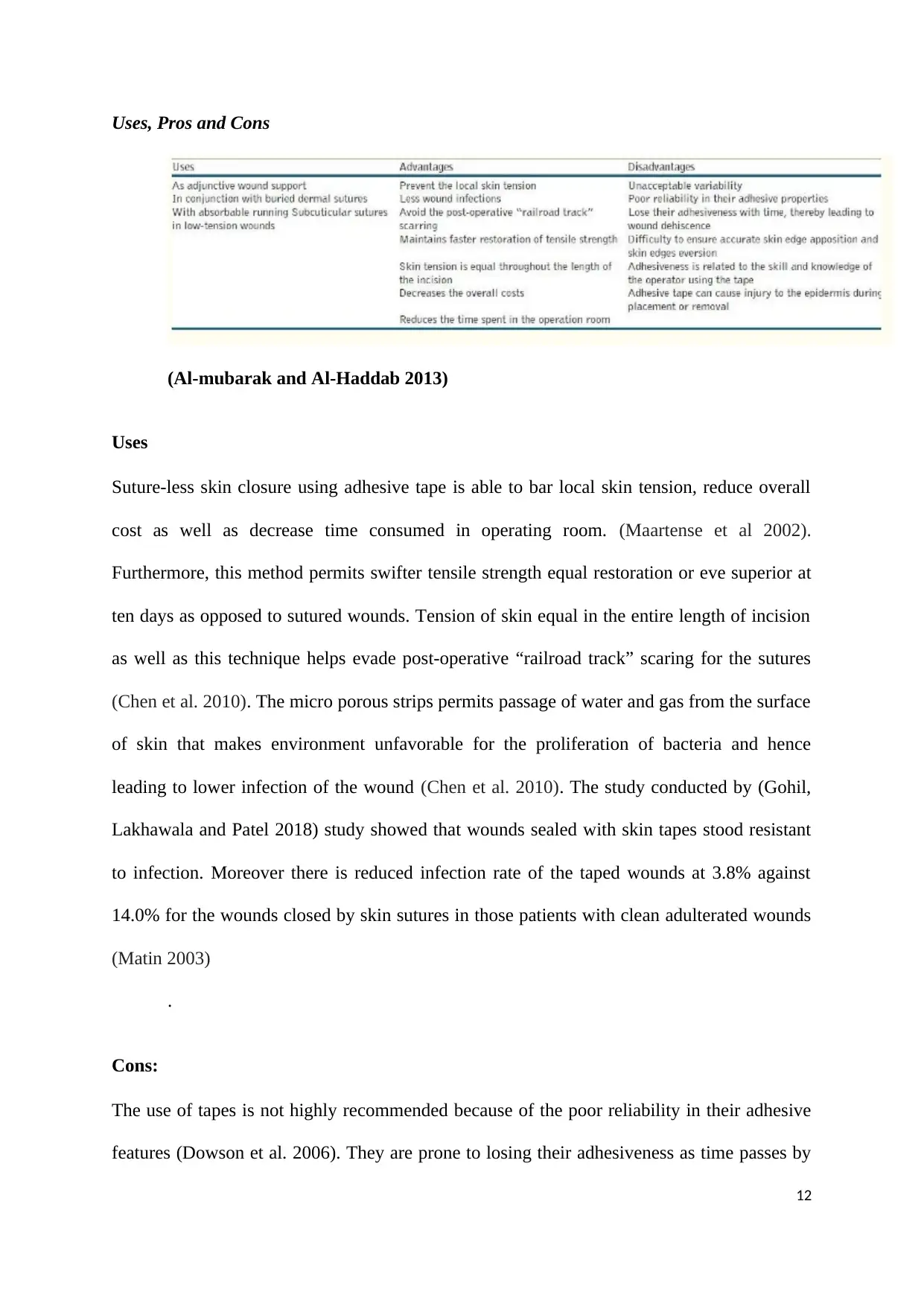
Uses, Pros and Cons
(Al-mubarak and Al-Haddab 2013)
Uses
Suture-less skin closure using adhesive tape is able to bar local skin tension, reduce overall
cost as well as decrease time consumed in operating room. (Maartense et al 2002).
Furthermore, this method permits swifter tensile strength equal restoration or eve superior at
ten days as opposed to sutured wounds. Tension of skin equal in the entire length of incision
as well as this technique helps evade post-operative “railroad track” scaring for the sutures
(Chen et al. 2010). The micro porous strips permits passage of water and gas from the surface
of skin that makes environment unfavorable for the proliferation of bacteria and hence
leading to lower infection of the wound (Chen et al. 2010). The study conducted by (Gohil,
Lakhawala and Patel 2018) study showed that wounds sealed with skin tapes stood resistant
to infection. Moreover there is reduced infection rate of the taped wounds at 3.8% against
14.0% for the wounds closed by skin sutures in those patients with clean adulterated wounds
(Matin 2003)
.
Cons:
The use of tapes is not highly recommended because of the poor reliability in their adhesive
features (Dowson et al. 2006). They are prone to losing their adhesiveness as time passes by
12
(Al-mubarak and Al-Haddab 2013)
Uses
Suture-less skin closure using adhesive tape is able to bar local skin tension, reduce overall
cost as well as decrease time consumed in operating room. (Maartense et al 2002).
Furthermore, this method permits swifter tensile strength equal restoration or eve superior at
ten days as opposed to sutured wounds. Tension of skin equal in the entire length of incision
as well as this technique helps evade post-operative “railroad track” scaring for the sutures
(Chen et al. 2010). The micro porous strips permits passage of water and gas from the surface
of skin that makes environment unfavorable for the proliferation of bacteria and hence
leading to lower infection of the wound (Chen et al. 2010). The study conducted by (Gohil,
Lakhawala and Patel 2018) study showed that wounds sealed with skin tapes stood resistant
to infection. Moreover there is reduced infection rate of the taped wounds at 3.8% against
14.0% for the wounds closed by skin sutures in those patients with clean adulterated wounds
(Matin 2003)
.
Cons:
The use of tapes is not highly recommended because of the poor reliability in their adhesive
features (Dowson et al. 2006). They are prone to losing their adhesiveness as time passes by
12
⊘ This is a preview!⊘
Do you want full access?
Subscribe today to unlock all pages.

Trusted by 1+ million students worldwide
1 out of 56
Your All-in-One AI-Powered Toolkit for Academic Success.
+13062052269
info@desklib.com
Available 24*7 on WhatsApp / Email
![[object Object]](/_next/static/media/star-bottom.7253800d.svg)
Unlock your academic potential
Copyright © 2020–2025 A2Z Services. All Rights Reserved. Developed and managed by ZUCOL.